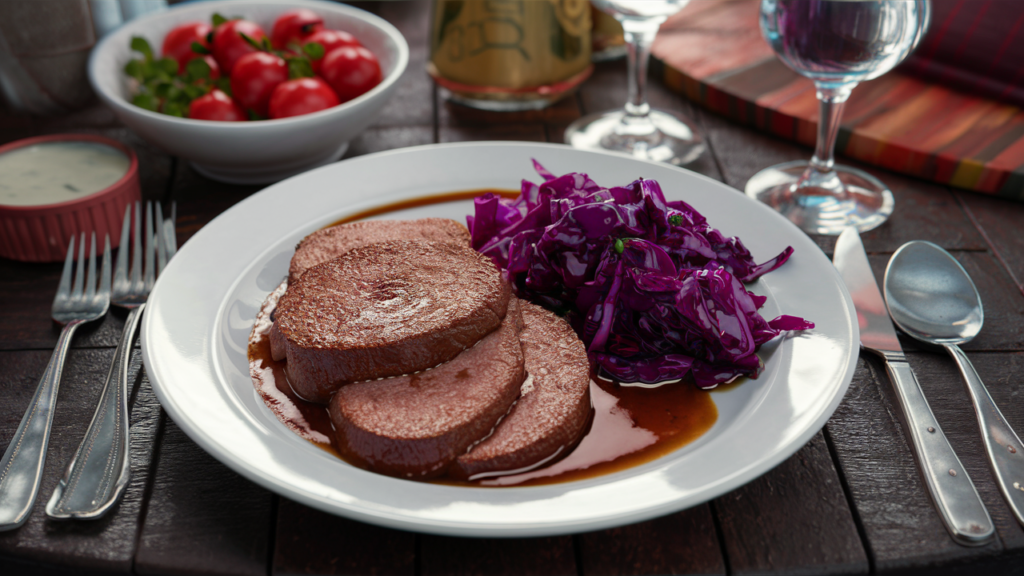Defying the Winter Chill: 5 Beloved German Dishes to Warm Your January
GERMAN HERITAGE USA | AFFILIATE DISCLAIMER: This post may or may not contain affiliate links which means we may receive a commission for purchases made through links. We will only recommend products that we have personally used or that we truly trust. Learn more on our Private Policy and Disclaimer Page located under our Terms Of Service tab above.
Germany might conjure images of lush green landscapes and vibrant summer festivals, but winter holds its own magic in the land of hearty food and heartwarming traditions.
As January paints the world white, Germans turn to a culinary repertoire specifically designed to combat the cold. These dishes are more than just meals; they’re comforting embraces, flavor-packed escapes from the winter blues.

So, grab your mittens, crank up the heat, and prepare to embark on a delicious journey through 5 iconic German dishes that will chase away the January chill:
1. Linsensuppe (Lentil Soup): A Humble Hero
Starting off with a classic, Linsensuppe is the epitome of German comfort food. This humble lentil soup, simmered with aromatic vegetables and seasoned with smoked sausage and bay leaves, is not only soul-warming but also incredibly nutritious.

Lentils are packed with protein and fiber, keeping you energized throughout the long winter days. The smoky depth of the sausage adds a delightful savory twist, while the vegetables lend pops of flavor and essential vitamins. A sprinkle of fresh herbs on top and a slice of crusty bread for dipping make this simple soup an absolute winner.
Lentil Soup Recipe
Ingredients: 1 cup brown lentils, 1 onion, diced, 2 carrots, diced, 2 celery stalks, diced, 4 cups vegetable broth, 1 bay leaf, 1 smoked sausage (like kielbasa), sliced, salt, pepper, fresh herbs for garnish (optional).
Instructions: Rinse lentils and soak in water for 30 minutes. Sauté onion, carrots, and celery in olive oil until softened. Add lentils, broth, and bay leaf. Bring to a boil, then simmer for 30 minutes or until lentils are tender. Add sliced sausage and season with salt and pepper. Simmer for another 10 minutes. Garnish with fresh herbs before serving.
2. Grünkohl mit Pinkel (Kale with Sausage): A North German Delight
Venture north, where the wind blows fiercely and the kale grows strong. Grünkohl mit Pinkel is a traditional dish from Lower Saxony, a hearty stew featuring dunkelbunt (a garlicky blood sausage) nestled amongst a bed of savory kale.

The kale is typically cooked with onions, bacon, and goose fat, resulting in a rich, flavorful base.
The dunkelbunt adds a unique savory-sweet punch that perfectly complements the earthy notes of the kale. This dish is best enjoyed with potatoes and a side of mustard, making it a true winter feast.
Kale with Sausage Recipe
Ingredients: 1 pound kale, chopped, 1 onion, diced, 2 strips bacon, diced, 1 tablespoon goose fat (or olive oil), 1 dunkelbunt sausage, sliced, 4 cups vegetable broth, salt, pepper, mashed potatoes, mustard.
Instructions: Rinse and roughly chop kale. Sauté onion and bacon in goose fat until softened. Add kale and cook until wilted. Pour in broth and season with salt and pepper. Bring to a boil, then simmer for 30 minutes or until kale is tender. Add sliced dunkelbunt and cook for another 10 minutes. Serve hot with mashed potatoes and mustard.
3. Sauerbraten (Marinated Roast): A Sweet and Sour Symphony
This quintessential German dish takes center stage during festive occasions and Sundays. Sauerbraten is a marinated roast, typically beef or venison, steeped in a tangy vinegar and red wine blend along with spices and herbs.

The result is a tender, flavorful meat with a complex sweet and sour profile. Often served with potato dumplings (kartoffelklöße) and red cabbage, Sauerbraten is a dish that demands attention and rewards it handsomely.
Sauerbraten Recipe
Ingredients: 2-3 pounds beef roast, 1 bottle red wine, 1 cup red wine vinegar, 1 onion, sliced, 1 carrot, sliced, 1 bay leaf, cloves, peppercorns, allspice berries, juniper berries, sugar, salt, potato dumplings, red cabbage.
Instructions: Combine red wine, vinegar, onion, carrot, bay leaf, spices, and sugar in a large pot. Bring to a boil, then simmer for 30 minutes. Add beef roast and marinate for at least 24 hours, turning occasionally. Remove roast from marinade and strain marinade. Brown the roast in a pan. Transfer roast to a Dutch oven and pour in strained marinade. Cover and bake at 325°F for 2-3 hours, or until tender. Slice the roast and serve with potato dumplings and red cabbage.
4. Käsespätzle (Cheese Spaetzle): A Swabian Comfort Classic
From the mountainous region of Swabia comes Käsespätzle, a dish that embodies pure comfort. These small, irregular noodles are made with eggs, flour, and salt, cooked in boiling water until they float, then tossed in melted butter and generously coated with grated cheese like Emmentaler or Gruyère.

The result is a delightfully chewy and cheesy dish that begs to be devoured. Traditionally served with crispy fried onions, Käsespätzle is a versatile dish that can be enjoyed on its own or as a side with sausages or salads.
Cheese Spaetzle Recipe
Ingredients: 2 cups all-purpose flour, 3 eggs, 1/2 teaspoon salt, water, 1 cup grated cheese (Emmentaler or Gruyère), butter, 1 onion, thinly sliced (optional).
Instructions: Combine flour, eggs, and salt in a bowl. Gradually add water, a tablespoon at a time, until a thick batter forms. Press batter through a spaetzle maker or grater into boiling water. Cook for 2-3 minutes until they float, then drain. Toss with melted butter and grated cheese. Heat butter in a pan and fry onions until golden brown (optional). Serve Käsespätzle topped with fried onions (optional).
5. Zwetschgenkuchen (Plum Cake): A Sweet Ending
No German winter feast is complete without a sweet indulgence. Zwetschgenkuchen, a traditional plum cake from southern Germany, is a perfect way to end a hearty meal. Made with a buttery yeast dough and topped with juicy plums, this cake is a beautiful balance of sweet and tart.

The crumble topping adds a delightful textural contrast, making each bite irresistible. Serve warm with a scoop of vanilla ice cream or whipped cream for an extra touch of wintery comfort.
Plum Cake Recipe
Ingredients: For the dough: 1 cup all-purpose flour, 1/2 cup sugar, 1/4 teaspoon salt, 7 tablespoons cold butter, cubed, 1 egg yolk, 1 tablespoon ice water. For the filling: 4-5 ripe plums, sliced, 1 tablespoon sugar, 1 tablespoon cinnamon powder. For the crumble: 1/2 cup all-purpose flour, 1/4 cup brown sugar, 1/4 cup cold butter, cubed.
Instructions: Prepare the dough by combining flour, sugar, salt, and butter in a bowl. Cut in the butter until crumbly. Add egg yolk and ice water, mix until just combined. Wrap dough in plastic wrap and refrigerate for 30 minutes. Preheat oven to 375°F. Roll out dough and transfer to a baking sheet. Top with sliced plums, sprinkle with sugar and cinnamon. Prepare crumble by combining flour, brown sugar, and butter. Crumble over the plums. Bake for 30-35 minutes, or until golden brown. Serve warm with ice cream or whipped cream.
With these five delicious recipes in your repertoire, you’re ready to conquer the January chill in true German style.
So, gather your loved ones, crank up the heat, and indulge in the warmth and flavor of these winter classics.
Guten Appetit!
